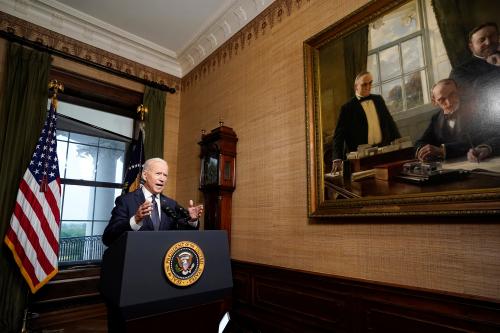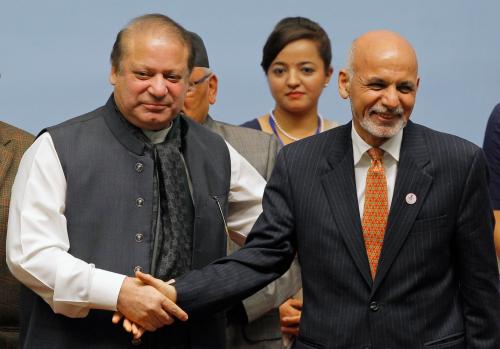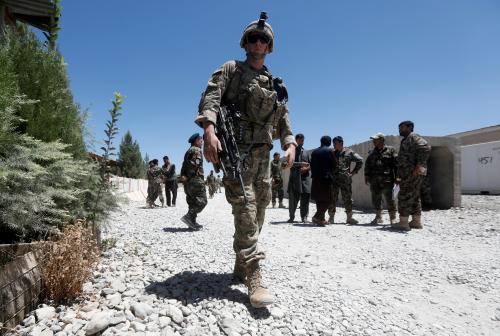This piece originally appeared in Defense One on August 13, 2021, prior to the fall of Kabul and the collapse of the Afghan government at the hands of the Taliban.
Afghanistan stands on the knife’s edge and history may hold President Joe Biden and his administration personally responsible if the worst comes to pass.
Of the roughly 400 districts that make up the country, most are now in the hands of the Taliban. Multiple provincial capitals have fallen and more are going down. The Taliban’s advance seems inexorable, with enemy momentum growing fast. Surrender ultimatums to the remaining provinces have been issued. Atrocities inevitably have followed, inflicting unspeakable violence especially upon those who served U.S. and NATO forces and the Kabul government. Special treatment is being reserved for Afghan women and girls. This is what the Taliban does. It is who they are. And we, after two decades of conflict, should not be at all surprised by this looming disaster.
Critically, there may however still be time for Biden to rescue both Afghan lives and American interests from this unfolding humanitarian catastrophe. We are fast approaching the true tipping point of this conflict, a moment that will change the entire paradigm of the U.S. departure from if we’ll need to re-intervene, to when and how.
While we’ve been here before with our premature departure from Iraq, the closer analogy is the collapse of Afghanistan in 1992, and the speed with which the provinces fell after the Soviet Union cut its support for the regime in Kabul and, four years later, the Taliban killed Afghanistan’s last communist leader, Najibullah. The Biden administration must act now if it is to prevent another such catastrophe.
Biden has only a short period of time to reverse his decision. He should begin by immediately considering the following several options:
Redline this conflict. The Biden administration should issue a public redline to the Taliban, with clear limits to their offensive combat operations and subsequent behavior in captured areas, beyond which the U.S. will intervene with military force. If done soon, just this announcement will help the Afghan government and give the Taliban pause. Specifics might include, at minimum and in the short term, a perimeter warning around Kabul, which if violated would result in a concerted military response against Taliban forces and leadership across Afghanistan. The Taliban must not be permitted to enter Kabul.
Issue prepare to (re-)deploy orders. Publicly announce that the Department of Defense has placed key American combat units on a prepare to deploy, or PTDO, status, in case the redline is crossed. The force list for this redeployment back into Afghanistan should be scalable and include special operations forces, advisors, and combat controllers in the early arriving forces, both to control American “over the horizon” air strikes and to place advisory elements with Afghan forces under pressure from the Taliban. Even if U.S. airpower remains based outside Afghanistan, these on-the-ground individuals will be essential if such strikes are to be effective in any meaningful way in halting the Taliban’s advance. Subsequent arriving forces could include long range, precision rocket artillery with security elements, including the surface-to-surface Army Tactical Missile System, or ATACM, to conduct 24/7 precision engagement and strikes on advancing Taliban elements converging on key locations and Kabul.
Within this overall force package, consideration should be given to reopening Bagram air base for the redeployment of American aviation elements, including fixed wing, attack rotary wing assets, and unmanned aircraft for long range, long duration surveillance and strike. We must also consider the means of getting critical maintenance contractors back in country—perhaps based yet again in Bagram—to support the flagging Afghan air force. Finally, the United States should consider redeploying Tier One SOF strike forces (SEALs, Delta Force, and Rangers) to conduct direct action strikes against Taliban leadership elements.
Conduct an Around-the-Clock Airlift of Special Immigrant Visa (SIV) and Other Eligible Afghans. While the United States prepares to intervene to preserve the Afghan government and slow or stop the Afghan onslaught, the full weight of the U.S. military and civil reserve air fleet assets should be brought to bear to extract those Afghans who would otherwise receive a SIV, or other special immigration consideration, including a P2 visa, humanitarian parole, or asylum. They should be moved short haul to intermediate American bases in the region and from there flown to the United States for consular processing. With the president’s timely decision to deploy a brigade combat team of some 3,000 soldiers into Kabul international airport to secure the departure of U.S. and other citizens, these American troops form the basis not just for the security of the evacuation of Americans, and of the forementioned Afghans, they can also serve as the security platform for the PTDO force list if the president elects to flow forces back into Afghanistan.
Even if these actions are taken with all due haste, it’s not clear, absent a major reinjection of American combat power, whether the Taliban momentum can truly be stopped, much less reversed. Indeed, the humanitarian crisis is already in full swing, and nothing is likely to emerge from the ongoing flurry of last-minute negotiations in Doha that will prevent the “Islamic Emirate of Afghanistan” from prevailing in some form. Much worse though, should the Taliban topple the existing government, nothing will stop Afghanistan from becoming the very terrorist platform and source of instability for which we fought 20 years to prevent. Biden rightly sought to end American’s longest war and made a decision to make this happen. But the consequences should have been foreseeable and now he must act quickly and decisively if he’s to avoid the looming catastrophe unfolding before our eyes.
I’ve written elsewhere about my serious concerns with the Trump administration’s efforts in Afghanistan, which dealt Biden a very difficult hand leading into the onset of his presidency. Unsurprisingly, the Taliban have not complied with virtually any of the stipulations of the February 2020 U.S.-Taliban peace deal and are now in the midst of a full-blown military offensive to topple the government of Afghanistan and again turn the region into a platform for terror and violence against the United States and our allies. Since U.S. and allied leaders pulled troops from Afghanistan, the Taliban are emboldened and unconstrained, with little reason to continue their sham act of modernity and civility. Indeed, there’s reporting coming out of Doha that Taliban there are saying they never intended to adhere to the deal Trump made.
While we were never going to stay in Afghanistan forever, how we inevitably left was nevertheless always going to set the course for its future, and in many respects the region’s. Biden’s decision to depart Afghanistan, which to many felt abrupt and against the advice of many of America’s senior leaders and experts, was deeply concerning in its seeming lack of the serious planning one would have expected for such a critical and long-standing policy issue. This approach has resulted in the makings of a true disaster not just for Afghanistan, but also for the administration and the values they champion and continually espouse. With our and our allies’ departure, the Taliban may soon achieve in a short time by force of arms what diplomacy might have taken years to accomplish otherwise.
Frantic calls by everyone—except the Taliban—for a last-minute peace deal with the Doha Taliban seems a fool’s errand. Why would the Taliban deal away any of their influence in a power sharing agreement with its nemesis, the Ghani government, if they can achieve complete control of the country from the battlefield? The threat of international isolation is ringing hollow, and the Taliban will still have Pakistan as an ally, and likely China.
The Taliban are operating with virtually complete impunity now, and until the first serious American pushback occurs, these people will continue to roll-up the country until the situation either sinks into complete civil war or worse—and the “or worse” scenario seems to be playing out now. For those saying an American redeployment will hurt the peace process: the Doha process never worked to begin with and is completely dead now that the Taliban believe themselves to have free rein on the battlefield.
With U.S. forces out of the picture there is no deterrent to the Taliban military options, and no practical means to slow or stop their momentum to create a logic for a diplomatic outcome, if one is even thinkable now. For those saying the Afghans should be doing this themselves: no one envisaged the United States precipitously pulling out virtually all of the aviation and other maintainers for the Afghan air force. With much of that force relying on sophisticated UH-60 Black Hawk helicopters, MD-530 Little Bird gunships, and A-29 Super Tucano ground attack aircraft, the wrench turning was done by American contractors. These Americans departed with U.S. troops, creating a foreseeable limit on the Afghans’ capacity to defend against the Taliban onslaught and fight back. Indeed, from its inception, the Afghan air force was never envisioned as operating in such a poorly supported environment.
The American concession, Operation Allies Refuge, which will airlift out of Afghanistan a small fraction of our interpreters, is too little too late and does little to help the thousands of other Afghans, including the many brave Afghan women activists, who were associated with the U.S.-led coalition and who’ll suffer directly from our departure. American and Western embassies in Kabul are under water with frantic applications for visas to evacuate. Indeed, just days ago on August 7, the U.S. embassy told Americans to get out while they still could. The embassies may all close shortly, further stranding Afghans desperately trying to get out.
So, if the logic of turning this crisis around can’t be established based on the despair, desperation, and human misery that it’s already created, turning around this decision might instead be made based on the following considerations:
Great Power Competition. With the U.S. embrace of great power competition, it’s ironic that the U.S. will be ceding the field in Afghanistan to the Chinese who will inevitably flow into the Afghan vacuum left by the U.S. departure. No one should have missed the explicit message sent by the Chinese in the recent warm and celebratory welcome of Taliban leader Mullah Abdul Ghani Baradar in Beijing. That welcome appeared in stark contrast to the cold and confrontational reception of the American envoy, Deputy Secretary of State Wendy Sherman.
With China on the ground there, a Taliban-ruled Afghanistan inevitably in league with China’s partner Pakistan creates several potential outcomes. First, it blocks India’s interests in Afghanistan, preventing the much-feared Indian encirclement of Pakistan, even though Indian contributions to Afghan development and to its future vastly exceeded most other nations, including China and Pakistan combined. Second, a compliant Taliban regime in Kabul creates the opportunity for a north/south trade corridor from the Russian sphere of Central Asia and the Central Asian Republics, across Afghanistan and the southern curve of Pakistan to Gwadar, the Chinese-built port on the Indian Ocean.
Finally, and in the context of strategic competition, the United States will now have to swim hard upstream to preserve or even exert any U.S. values-based influence in the region for a very long time. The United States will be hard pressed to find allies to join us, as well. It’s unlikely the United States would have a welcome role in a Chinese-brokered regional trade scheme, but it’s entirely likely that with Beijing and Moscow in the driver’s seat across much of Central and South Asia, Iran could become a more constructive player.
Afghanistan as a platform for regional and international terror and instability. A Taliban-ruled Afghanistan will become a platform for terror groups and long-range terror operations. With the Taliban in charge in Kabul, the terror-limiting border between Afghanistan and Pakistan functionally disappears, and the terrorist groups that inhabit and thrive in border reaches of both countries can move freely back and forth. The situation may closely resemble the emergence of the Islamic State, or ISIS, which took advantage of the utter destabilization of eastern Syria and northwestern Iraq to create their platform of terror and destruction.
Further, the Taliban never severed its relationship with al-Qaeda—those responsible for the 9/11 attacks, for which we will soon mark the 20th anniversary—as they promised Trump they would do. So, while al-Qaeda still ostensibly hid from American in-country counterterrorism capabilities, there will be little to deter their operating openly from the Hindu Kush with U.S. forces gone. The idea of “over the horizon” counterterrorism operations was and remains a very challenging undertaking without credible ground controllers. Meanwhile, the Haqqani network, which was never really under pressure from Pakistani security forces, will be completely unpressurized from a Taliban-ruled Afghanistan. Those who persist in believing the Haqqanis are a local regional phenomenon, would do well to remember their fundraising efforts from the usual suspects in the Gulf, and the training base it provided for the failed vehicle bomb in Time Square in 2010. Pakistan must come to grips with a scenario it’s never wanted: the Pashtuns united under a fundamentalist government in Kabul.
Lashkar-e-Tayyaba, or LeT, and other groups of this ilk also have taken up residence in Afghanistan. LeT is a Kashmiri separatist group that is virulently hostile to India. It was responsible for the attack on the Taj Mahal hotel in Mumbai, in 2008, which nearly set two nuclear powers on a war footing. With the nationalist Modi government in Delhi, another attack of this kind launched from Afghan or Pakistani territory could be catastrophic for the region. Its presence and other similar groups in Afghanistan is a threat to regional security and beyond. And then there is the Khorasan Province of the Islamic State, or ISIS-KP. It’s unclear whether in the aftermath of a Taliban takeover ISIS-KP wouldn’t join the Taliban and al-Qaeda.
Separately, the region also is bracing for the criminality of the Taliban, including drugs, weapons, and human trafficking into Iran and the Central Asian states, as well as support for the Islamic insurgencies already within their borders who would be emboldened and supported by an emirate in Kabul.
Finally, despite what some are saying, the war in Afghanistan was never just about killing Osama Bin Laden. The United States was intent on tracking down and eliminating him, but the war in Afghanistan was not about him. The whole purpose of our 20-year effort in Afghanistan was to prevent a resurgence of al-Qaeda and the likelihood of new attacks on the United States and our allies, and to prevent the Taliban from overthrowing the installed government in Kabul. When the U.S. found bin Laden hiding in Pakistan, he was dealt with, but that was not the end of the war. If Kabul falls, because of the U.S. evacuation, both objectives will have failed.
As we navigate this moment, some are conjuring the ghost of Saigon in 1975, and others would say this is a repeat of the 2014 ISIS moment when the U.S. had to return to Iraq because of our premature departure in 2011. Maybe there’s some of both of these histories and unlearned lessons at work here. But there is also the fear this will end in a manner more akin to Afghanistan’s collapse in 1992, when the Soviet Union finally pulled the plug on its Afghan allies. And while no one can imagine a modern repeat of the fate of Najibullah, defiled and strung up in Kabul by Taliban forebears, there is nothing the Taliban will not do, and we’re being reminded daily. Indeed, recent reporting of Afghan women, some as young as 15, being forced to marry Taliban fighters serves both as a horrifying reminder of what this group is capable of, as well as their similarities to another odious group: ISIS.
The anguished cries coming from Afghanistan are now deafening, none more so than from the women, who are already suffering under the Taliban lash. History’s judgment of this moment will be swift and harsh about who lost Afghanistan. Given the president’s clear and long-held commitment to American values and his important leadership in so many other areas, such an outcome in Afghanistan is simply baffling, and would be devastating to the credibility of his critical message that “America is Back”.
The Brookings Institution is committed to quality, independence, and impact.
We are supported by a diverse array of funders. In line with our values and policies, each Brookings publication represents the sole views of its author(s).






Commentary
Op-edJohn Allen: Biden must reverse his decision to quit Afghanistan
August 13, 2021